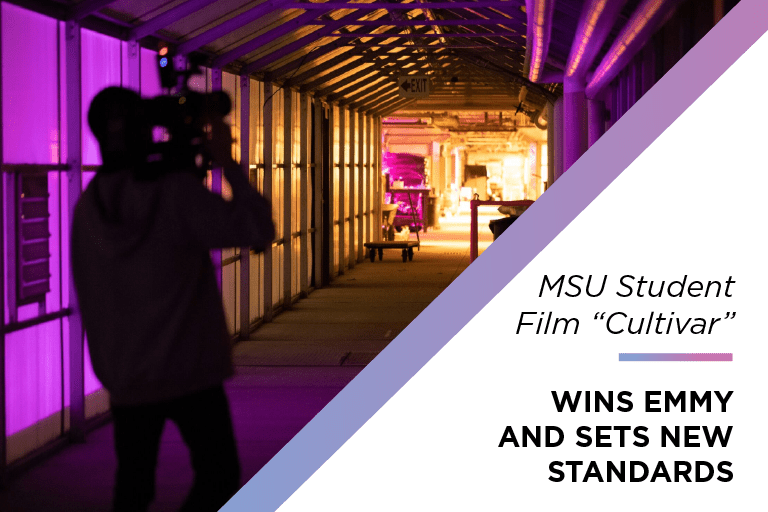A short film produced by a team of ComArtSci students and alumni took top honors in April at the Michigan Chapter of the National Academy of Television Arts and Sciences Student Production Awards.
The film “Cultivar” earned an Emmy in the category of Best College Long Form Fiction Film. The “what” is a horror thriller story of a science experiment gone wrong. But the “how” of this project’s creation is — as the legendary Paul Harvey would say — the rest of the story.
The idea for the film first germinated in December 2022.Amol Pavangadkar, a senior teaching specialist in the School of Journalism, says it was an opportunity to depart from the normal classroom experience.
“We wanted something different,” said Pavangadkar. “We did not need a syllabus per se. We wanted to invite a bunch of students who really were passionate about creating content. Some took independent study credits, and others just wanted to be there for the experience.”
Working in tandem with Academic Technology Coordinator Brian Kusch and WKAR Senior Director of Television and Digital Operations Brant Wells, Pavangadkar created a special topics class. Through his connections with Red Digital Cinema, he obtained a high-end 8K resolution Red V-Raptor demo camera free for one month.
Nolan Duff, a 2023 Film and Video Production graduate, served as the project’s cinematographer and postproduction lead.
“It was very exciting to get my hands on some cinema cameras,” said Duff. “They’re a lot harder to work with in post-production. We don’t get a lot of experience working with raw footage in our film classes at school.”
Their camera recorded images in a flat color profile. Colors, lighting and shadows had to be manipulated in post-production to achieve the desired effect. In “Cultivar,” the story of a potentially cancer-curing plant that turns deadly, the visual characteristics of the plant were paramount to the plot.
Duff says the experience was like painting colors onto the screen.
“Essentially, that’s what you have to do when you're working with raw footage,” Duff said. “You have to understand how to manage it in a scientific workflow to be able to manipulate the colors and make it look exactly how you want.”
“Cultivar” required a significant amount of effort beyond what students normally encounter in most MSU film courses. There were many stressful moments along the way. Budget constraints. Early morning shoots that turned into late nights. Technical failures. There were personal sacrifices, too. Most of the principal photography was shot during spring break, and many cast and crew willingly gave up their time to devote to the project.
Amol Pavangadkar says everyone had to push through their challenges.
“Morale was actually never a big problem during production,” he said. “Where we noticed a big drop off was during post-production. That’s always a big challenge on all (film) sets. You essentially feed off everybody else's energy. At times, you are the energy source; at other times, you’re the energy receptor. And this was exactly the case on this production.”
Once the scenes were shot and the actors’ performances delivered, another layer of complexity emerged. The crew was required to create a DCP, or digital cinema package. It’s a collection of audio and image files containing metadata and other coding.
Advisor Brian Kusch says the team learned how tedious the task of creating a DCP can be.
“They had no idea about that whole process,” Kusch said. “It was an enormous amount of work to get to the finish line. From what I saw, I think that was the biggest eye opener for them. [Usually] it’s like, oh, we shot our movie, here’s the edit; we’re done. This was like, no…you’re only halfway done.”
Kusch says throughout the project, he, Pavangadkar and Wells acted more like clients than instructors, pushing them to a real-world level of production.
“When something didn’t make sense, we made them change it,” Kusch said. “There were many things they had to redo to get it up to a better standard. In the real world, you must do what the client wants whether you agree with it or not. I don’t think the students get that level of pushback in their normal classes.”
For Nolan Duff, the “Cultivar” experience was a foretaste of what he expects to be doing in the industry.
“I’m hoping to be a cinematographer on some larger productions,” said Duff. “I enjoy films, but I can see myself probably working on a TV series. That’s where I’d really like to land.”
“Cultivar” is believed to be the first film ever produced at MSU to be shot in 8K. Amol Pavangadkar calls it “groundbreaking.” He says the program is already planning new course material based off this model.
“We will be following a similar template for the new special topics class that we just started,” said Pavangadkar. “This will be running over two semesters, Fall 2024 and Spring 2024. The intention is not just to stick to a short film. We will be doing commercials, public service announcements and some environment related content as well. The tools will keep on evolving, and we need to follow that growth pattern…but we have to appreciate that at the core is the process and the technique. This certainly will become a hugely successful enterprise if we keep on tweaking it.”
Pavangadkar says students who are interested in the new special topics class should contact him directly, at which point they’ll be placed on a waiting list. It will be up to the course instructors to admit students into the class. The special topics class will be capped at 18 students each year.
By Kevin Lavery
